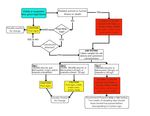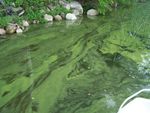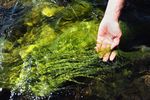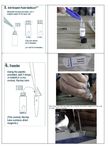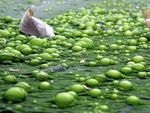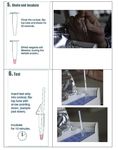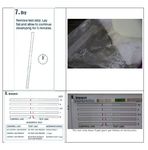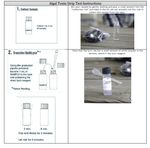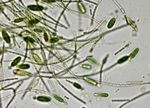Harmful Algal Bloom (HAB) Guidance Document for Montana - May 2019 - dphhs
←
→
Page content transcription
If your browser does not render page correctly, please read the page content below
HAB Guidance Document for Montana TABLE OF CONTENTS Table of Contents ........................................................................................................................................... i List of Tables .................................................................................................................................................. i List of Figures ................................................................................................................................................ ii 1.0 Introduction ............................................................................................................................................ 1 1.1 Background ......................................................................................................................................... 1 1.2 Cyanotoxins ......................................................................................................................................... 2 1.3 Exposure Pathways ............................................................................................................................. 3 1.4 Animal Exposure ................................................................................................................................. 4 2.0 Guidelines and Advisories ....................................................................................................................... 5 2.1 Finished Drinking Water ..................................................................................................................... 5 2.2 Recreational Water ............................................................................................................................. 5 2.3 Advisories ............................................................................................................................................ 6 2.4 Managing Jurisdiction ......................................................................................................................... 7 3.0 Monitoring and Testing........................................................................................................................... 8 3.1 Visual Assessments ............................................................................................................................. 8 3.2 Field Tests ........................................................................................................................................... 9 3.3 Laboratory Analysis ............................................................................................................................. 9 3.4. Sampling Procedures ....................................................................................................................... 11 3.5 Reporting........................................................................................................................................... 12 4.0 Contacts and Resources ........................................................................................................................ 12 4.1 Montana State HAB Team................................................................................................................. 12 4.2 Resources .......................................................................................................................................... 13 5.0 References ............................................................................................................................................ 14 Appendices.................................................................................................................................................. 15 Appendix A – Abraxis Test Strip Instructions .......................................................................................... 16 Appendix B - Region 8 EPA, Total Cyanotoxin Sampling Procedures, June 2015 ................................... 20 LIST OF TABLES Table 1. EPA Drinking Water Health Advisory for Cyanotoxins .................................................................... 5 Table 2. Montana HAB Public Health Advisory Tiers for Recreational Waters ............................................. 6 Table 3. Members of Montana State HAB Team ........................................................................................ 12 May 2019 i
HAB Guidance Document for Montana LIST OF FIGURES Figure 1. Cyanobacteria and Green Algae Examples .................................................................................... 2 Figure 2. Common Cyanobacteria Species Under a Microscope .................................................................. 3 Figure 3. Decision Flow Chart for Harmful Algal Blooms in Recreational Water and Private Water Users . 8 May 2019 ii
HAB Guidance Document for Montana 1.0 INTRODUCTION The purpose of this document is to provide guidance to local, state, federal, and private landowners to protect people, pets, and livestock from the effects of harmful algal blooms (HABs) in Montana. This guide discusses the general process, factors to consider, and suggestions and recommendations to consider when a waterbody is experiencing a potential HAB. The document provides helpful hyperlinks within the text for more information as well as a HAB contact and resource section. This guide was developed by the Montana State HAB Team. The HAB Team includes members from the Department of Environmental Quality (DEQ), Department of Public Health and Human Services (DPHHS), and Fish, Wildlife and Parks (FWP). This is not a statewide policy and only serves as recommendations and guidance. The guide is a compilation of information from states and federal agencies that have established HAB guidelines. Other states and organizations that provided information include: Environmental Protection Agency (EPA), Colorado Lake and Reservoir Management Association, Utah Department of Health, Utah Department of Environmental Quality, World Health Organization, California Environmental Protection Agency. 1.1 BACKGROUND A HAB consists of cyanobacteria, also known as blue-green algae, a common phytoplankton in Montana’s waterbodies. Their primary distinction from other algae is that they are prokaryotic (no membrane bound organelles). Cyanobacteria are aquatic, unicellular, and quite small but often grow in colonies large enough to be able to see; they create their own energy from photosynthesis like other eukaryotic phytoplankton. Cyanobacteria are naturally-occurring photosynthetic bacteria found in many habitats (including recreational waters). Potentially toxic blue-green algae occur throughout Montana in any standing bodies of water exposed to the sun, e.g., lakes, reservoirs, stockponds, and roadside ditches. They are not as common in rivers, streams, springs, or irrigation canals. All cyanobacteria are capable of producing toxins (cyanotoxins). When dense algae populations develop, especially cyanobacteria, they often (though not always) turn the water a greenish or blue-greenish color referred to as a “bloom.” Dense blooms near the surface may resemble a layer of green latex paint or spilled milk (Figure 1). HABs can occur in a variety of colors, including bright blue, green, white, brown, and red. More than one color may be present. HABs occur when naturally occurring cyanobacteria quickly multiply to high densities and form visible water discoloration, scums, and/or mats. They may also give off a foul odor. They can occur year round, but are most common in the summer when abundant sunlight and warm, stagnant water combine with high nutrient levels. There is no way to determine if a suspected bloom is toxic just by looking at it. Just because there is a cyanobacteria bloom doesn’t mean that cyanotoxins are present or being released into the water and, at the other end of the spectrum, cyanotoxins can be present when there is no bloom. It is also easy to mistake growths of green algae for HABs. Visual examples of cyanobacteria and green algae are presented in Figure 1. May 2019 1
HAB Guidance Document for Montana
Figure 1. Potentially toxic cyanobacteria versus nuisance green algae examples
a. Green Algae Example b. Green Algae Example
c. Blue-Green Algae (Cyanobacteria) d. Blue-Green Algae (Cyanobacteria)
1.2 CYANOTOXINS
Freshwater cyanotoxins in Montana include microcystins, cylindrospermopsin, and anatoxin-a. While no
human deaths caused by direct contact with cyanotoxins have been confirmed in the U.S., they have
been known to kill pets, livestock and wildlife. Deaths to pets and livestock by drinking cyanobacterial
blooms have been documented in Montana. Exposure to the cells themselves can result in less serious
health effects, even when no cyanotoxins are present. Limited cyanotoxin data exists for Montana and
cyanobacteria data has only been collected on specific waterbodies. Two species common to Montana--
Aphanizomenon Flos-aquae and Microcystis Aeruginosa-- have produced toxins elsewhere. Common
cyanobacteria species are shown in Figure 2.
Microcystin are a group of at least 80 toxin variants, microcystin-LR is the most toxic. They are produced
by Microcystis, Anabaena, Planktothrix, Nostoc, Hapalosiphon, Anabaenopsis, and Snowella Lacustris.
Microcystin is a hepatotoxin, affecting the liver, causing serious acute symptoms and also slower chronic
symptoms. Symptoms can occur hours or days after being exposed to the cyanotoxin. Signs include
abdominal pain, loss of appetite, jaundice, dark or reduced urine, diarrhea, vomiting, liver damage, and
hemorrhages.
May 2019 2HAB Guidance Document for Montana
Anatoxin is a neurotoxin produced by a number of cyanobacterial genera including Anabaena,
Aphanizomenon, and Planktothrix. Neurotoxins affect the nervous system and can occur very quickly.
Signs can appear within 15 -20 minutes after ingestion. Signs include numbness of the lips, tingling in
fingers and toes, stumbling, seizures, paralysis, disorientation, headaches, inactivity, elevated heart rate,
dizziness, and respiratory failure.
Cylindrospermopsin is another liver toxin that can be found in Cylindrospermopsis, Aphanizomenon,
Anabaena, Umezakia, and Raphidiopsis. The toxin can also damage other major organs (kidney, lung,
spleen, thymus, and heart).
Dermatotoxins affect the skin and can be produced by various cyanobacteria species with or without
other toxins. Symptoms can occur quickly if the skin is not rinsed after contact with cyanotoxins. Signs
include rashes, hives, swelling, itching, and excessive drooling and seizures. Dermatotoxins are not
specifically part of toxin testing, although high cyanobacteria cell counts usually indicate the presence of
dermatotoxins and the increased likelihood of associated illnesses.
Figure 2. Common Cyanobacteria Species Under a Microscope
a. Anabaena b. Microcystis c. Cylindrospermopsis
1.3 EXPOSURE PATHWAYS
If cyanobacteria are producing toxins, cyanotoxins can be released into the water as cyanobacteria grow
and die. Toxin concentrations can become elevated, particularly during a bloom event, concentrate
along shorelines, and can persist in the environment after a visible bloom is over.
The primary exposure pathway for cyanotoxins is through ingestion of water. Ingestion of water can
occur through both incidental and intentional pathways. Incidental ingestion is more likely in
recreational waters. The risk of incidental ingestion is particularly high for children playing in near-shore
areas since these areas are also where scums tend to accumulate.
Dermal irritant or allergic effects are possible from skin contact with cyanobacteria; however, the
cyanotoxins are not likely to cross the skin barrier and enter the bloodstream. Inhalation and aspiration
of toxin is possible, especially through activities where the toxin is aerosolized, such as water skiing or
splashing.
A possible scenario for the intentional ingestion of recreational water is the use of lake water for
drinking or cooking purposes by campers, hikers and backpackers. Camping filters, tablets, and boiling
will not remove cyanotoxins. There is insufficient information to determine the risk of consuming fish
caught in waters with toxigenic cyanobacteria. At a minimum, the fish should be rinsed with potable
water and the organs should be removed and discarded prior to cooking fillets.
May 2019 3HAB Guidance Document for Montana Montana public water suppliers are not federally mandated to monitor or treat for cyanotoxins. Thus, there is potential risk to consumers whose drinking water is sourced from a lake or reservoir during HAB season. Landowners with private drinking water sources from lakes or reservoirs with HAB potential are also at risk and should be cautious during HAB season. Do not drink water sourced from a HAB identified water body. 1.4 ANIMAL EXPOSURE Pets and livestock may be at higher risk for cyanotoxin poisoning since they are more likely to drink contaminated water. Late summer, times of drought, or wind blowing a bloom toward the animal access points are the times of greatest concern for livestock poisoning due to cyanotoxins. Immediate symptoms may include vomiting, diarrhea, dark urine, excessive thirst, shaking, itching, rash, respiratory paralysis, and death. Chronic exposure may include symptoms of anorexia, mental derangement, dehydration, hypoglycemia, and death. If you suspect the presence of a HAB, do not let your pet or livestock drink the water. In the case of no other water source, the waterbody in question should be tested for cyanotoxins immediately. Section 3 discusses testing methodologies. If your pet or livestock has ingested a water source that is potentially or verifiably contaminated with cyanotoxins, call your veterinarian immediately and report the incident on HAB.MT.gov. If your veterinarian is unfamiliar with cyanotoxin poisoning, please have them contact members of the State HAB Team or the State Veterinarian (Section 4.0). Additional information on animal cyanotoxin poisoning is available on the Centers for Disease Control and Prevention (CDC) website. In the case of a livestock death, the U.S. Department of Agriculture (USDA) Farm Service Agency (FSA) may be able to provide financial assistance through the Livestock Indemnity Program (LIP). To be eligible for livestock reimbursement through LIP, a water test is required to confirm the presence of cyanotoxins, and a veterinarian must provide proof of loss. Livestock producers can contact their local FSA office for assistance. There are also funding opportunities available for livestock producers looking to provide livestock a new water source, such as an off-stream water or other grazing best management practices, that can reduce the risk of HAB exposure. These include but are not limited to the USDA Natural Resources Conservation Service (NRCS) Environmental Quality Incentives Program (EQIP) and DEQ’s Nonpoint Source Pollution 319 Funding. Interested landowners can contact their local NRCS field office or the Nonpoint Source Program for more information. May 2019 4
HAB Guidance Document for Montana
2.0 GUIDELINES AND ADVISORIES
2.1 FINISHED DRINKING WATER
Finished drinking water is the transformation of raw water from surface water or groundwater sources
into drinking water that is compliant with the Safe Drinking Water Act using an appropriate treatment
technology. EPA has issued Drinking Water Health Advisories for the cyanobacterial toxins microcystins
and cylindrospermopsin. Recommended health advisory levels are at or below 0.3 micrograms per liter
for microcystins and 0.7 micrograms per liter for cylindrospermopsin in drinking water for children pre-
school age and younger (Table 1). It is important to remember that these concentrations apply to
finished drinking water. For school-age children through adults, the recommended HA levels for drinking
water are at or below 1.6 micrograms per liter for microcystins and 3.0 micrograms per liter for
cylindrospermopsin. Young children are more susceptible than older children and adults as they
consume more water relative to their body weight. Health advisories are non-regulatory values, rather
they serve as informal technical guidance to assist federal, state and local officials, and managers of
public or community water systems to protect public health from contaminants. EPA has also published
health effects support documents for the cyanobacterial toxins microcystins and cylindrospermopsin.
These documents contain the health effects basis for the development of health advisories for the
protection of human health. In addition, EPA has published a health effects support document for
anatoxin-a but concluded that there was not adequate information to support a health advisory for this
toxin.
Table 1. EPA Drinking Water Health Advisory for Cyanotoxins (EPA, 2015a,b)
Cyanotoxin Bottle-fed infants and pre-school School-age children and adults1
1
children
Microcystins 0.3 ug/L 1.6 ug/L
Cylindrospermopsin 0.7 ug/L 3 ug/L
1
10 Day Exposure
Montana Public Water Suppliers (PWS) are not required to monitor for cyanotoxins because cyanotoxins
are not a federally regulated contaminant. It is up to the individual public water supplier to voluntarily
monitor for cyanotoxins.
For more information, the DEQ’s drinking water contact is Lisa Kaufman and can be reached by phone:
406-444-5313, or by email: LKaufman@mt.gov.
2.2 RECREATIONAL WATER
Montana has developed a three tier approach to public health advisories incorporating both World
Health Organization (WHO) and EPA guidelines as shown in Table 2. The elevated cyanotoxin levels
detected under Tier 2 pose more health risks than levels detected under Tier 1; however, it is difficult to
test cyanotoxins frequently enough to determine when conditions change. Therefore, the State HAB
Team recommends posting Caution signs for both scenarios and investing more time notifying water
users if conditions reach Tier 2.
May 2019 5HAB Guidance Document for Montana
Table 2. Montana HAB Public Health Advisory Tiers for Recreational Waters
Tier 1: Caution Tier 2: Caution Tier 3: Consider Closure
Relative Probability of Low Moderate High
Acute Health Effects1
Cyanobaceterial Cell 100,000
1
Density (cells/mL)
Microcystins (ug/L)1,2 20
3
Anatoxin-a (ug/L) Non-Detect Detect – 20 > 20
Additional Factors Visual presence but no Reports of animal Reports of human illness
reported illness illness or death
Health Risks1 Negligible Short-term effects Short-term effects such
such as skin irritation as skin irritation nausea,
nausea, vomiting, vomiting, diarrhea.
diarrhea. Potential for Potential for long-term
long-term effects. effects and acute
poisoning.
Recommended Actions Post caution signs, Post caution signs, Post closure signs, notify
visually monitor for notify private water private water users and
changes users and media with media with advisory,
advisory closures
1
WHO, 2003, 2EPA, 2019, 3CSWB, 2016
2.3 ADVISORIES
Recommended health advisories should be based on the guidelines and recommendations in Table 1
and 2 following the decision flow chart shown in Figure 3. For public drinking water suppliers, the State
HAB team recommends notifying users after the first positive detection of cyanotoxins and following up
with laboratory testing for confirmation. Each public water supplier may have a plan that describes how
to notify water users in case of an emergency. It is recommended that the public water supplier develop
a plan if one is not in place. The drinking water advisories would be based on Table 1. If toxicity exceeds
these guidelines, all users should be notified as to not drink the water until further notice.
For recreational waters, the water managers or regulatory authorities can print and laminate advisory
signs from the following address:
https://dphhs.mt.gov/publichealth/Epidemiology/hab. HABs and cyanotoxin conditions can change
rapidly, often more quickly than is feasible to monitor for change. Due to this limitation, the State HAB
team recommends posting Caution signs under most scenarios, even when cell densities or toxin
concentrations reach Tier 2 conditions (Figure 3). Given the greater human health risk associated with
Tier 2 conditions, water users and/or the media should be notified. If cell densities or toxin levels reach
Tier 3 conditions, or if there are any reported animal or human deaths or illnesses, the State HAB Team
recommends the managing jurisdiction (Section 2.4) immediately post caution signs and consult with
State or County Human Health officials to determine next steps. This may include conducting
subsequent field or laboratory testing (Section 3.0) and/or posting closure signs and closing the
waterway.
May 2019 6HAB Guidance Document for Montana If there are no reported illnesses and a blue-green algal bloom has been visually verified (Section 3.1), it is recommended that the managing jurisdiction post caution signs. The managing jurisdiction has the option to then continue to monitor visually for any changes or to conduct field testing (Section 3.2). If the field testing yields a positive result for cyanotoxins, the State HAB Team recommends confirmation through laboratory analysis (Section 3.3). It is also recommended that caution signs remain in place if the field test returns a negative result. The caution sign should remain in place for at least two weeks after any visual signs of the algal bloom has dissipated. The results of the laboratory testing will better direct the jurisdiction as to what level of advisory is needed (Figure 3, Table 2). After an advisory has been issued, it is recommended that the jurisdiction conduct field and/or laboratory testing at a minimum of every two weeks. At least two weeks of results indicating that the hazard has passed is recommended before removing or downgrading any advisory. 2.4 MANAGING JURISDICTION A managing jurisdiction for a waterbody may include local health boards, local water user organizations, state and federal agencies, and private landowners. The local health boards and health officers have general authority to post health advisories and close water bodies per Montana Code Annotated (MCA) 50-2-116 and 50-2-118. The local health boards and health officers may also work with other managing jurisdictions to post advisories. The State HAB Team requests all local managing authorities passively monitor for HABs within their jurisdictions and report any suspected HABs to HAB.MT.gov. A managing jurisdiction has the greatest familiarity and access to their local waterbody and would likely be the first to recognize a HAB before any other agency. This guidance is not suggesting that jurisdictions develop a HAB monitoring plan, rather encourages a local “eyes on the ground” monitoring approach. For any managing jurisdictions that would like to develop an active HAB monitoring plan, the State HAB Team can provide review and assistance. Shorelines under state (FWP and State Lands) or federal control (BLM, BOR, and Forest Service) are the responsibility of the respective agency to monitor, test, and issue appropriate advisories. For privately accessed water bodies or shorelines, it is the responsibility of the private landowner to determine HAB concerns. The authority to notify the media rests with the jurisdictional agency. The State HAB Team can provide recommendations as to how and when to notify the media. In the case of an extensive bloom that has the potential to affect multiple jurisdictions, it is recommended that all agencies coordinate with the State HAB Team to issue a unified message to the public. The state recommends notifying any water users and the media for publicly accessible waterbodies when a Tier 2: Warning or Tier 3: Danger advisory is issued (Table 2). This may include notifying the local paper and television news station. The State HAB Team can assist in media releases and provide pertinent information necessary to protect public health. It is strongly recommended that the responsible agency or landowner work in coordination with the State HAB Team during all stages of a potential bloom. May 2019 7
HAB Guidance Document for Montana Figure 3. Decision Flow Chart for Harmful Algal Blooms in Recreational Water and Private Water Users 3.0 MONITORING AND TESTING Monitoring and testing is not mandated by the State. The State HAB Team does recommend that all managing jurisdictions visually monitor for cyanobacteria and report any occurrences to HAB.MT.gov. But if a HAB is visually verified, the State HAB Team recommends the sequence of monitoring, testing and advisory activities shown in Figure 3. Each jurisdiction is responsible for monitoring and testing. As discussed in Section 2.4, the State HAB Team recommends at a minimum, passive monitoring or an “eyes on the ground” approach to identifying HABs. Test kits and laboratory assistance is available at no cost through the State HAB program on a limited basis. Contact HAB@mt.gov for more information. 3.1 VISUAL ASSESSMENTS If a potential bloom is identified, a visual assessment is recommended. A visual assessment includes documenting the color and physical nature of the bloom (e.g., floating scum/mats) using a digital camera (please take photos both close-up and of the extent of the bloom). In addition, the locations and extent of the bloom should be noted, especially if it is present near any public access. All visual assessments and photos should be reported through the state reporting system HAB.MT.gov. The State HAB Team (Section 4.0) can assist in visual verification of a potential bloom. May 2019 8
HAB Guidance Document for Montana 3.2 FIELD TESTS After a bloom has been visually verified, field tests are recommended. Easy to use strip tests are helpful in detecting the presence/absence of cyanotoxins and can be performed in the field without laboratory equipment. These strips will only indicate if the concentration of the cyanotoxin is above some fixed value specific to each type of test strip (e.g., 5 µg/L). A limited supply of test strips is available from the State HAB program, HAB@mt.gov. Test strips are also available directly from the manufacturer, Abraxis,Inc., at the cost to the managing jurisdiction (described in Section 2.4). Each test strip costs $30 to $50 depending on the cyanotoxin tested. Test strips can detect anatoxin-a, cylindrospermospsin, and miscrocystins toxins in source drinking water, finished drinking water, and lake/reservoir/pond water. As such, the managing jurisdiction should decide which of these types of field test kits is most appropriate for their situation. At a minimum, microcystin field testing should be performed for a water body with visual cyanobacteria confirmation. The manufacturer has specific user guidelines that should be followed for accurate results. The test strip instructions are provided in Appendix A and available for download at Abraxis, Inc. Additionally, test strip instructions will be made available to those who are acquiring test strips from the State HAB Team. Test strips can be tricky to read. For confirmation of the reading, take a picture of the test strip and send it to the State HAB Team. For additional sampling procedures see Section 3.4. Field tests should target areas with the highest likelihood or risk of animal or human-cyanotoxin interaction and exposure. These areas may include beaches, shoreline access areas, drinking water intakes, stock watering ponds, etc. The GPS location and general description of sample location should be recorded in field notes. It is important to note that the field tests will only produce semi-quantitative results for one specific cyanotoxin and serve as an initial screening process for the presence of cyanotoxins. The test strips will not accurately measure cyanotoxin concentrations, speciate cyanobacteria, or provide cyanobacteria cell counts. Laboratory analysis can be performed for verification of toxicity, speciation, and cell count. Field test results above the detection limit of the test strip procedure should initiate caution sign posting in the affected area and are best followed up with laboratory analysis for confirmation. Positive cyanotoxin detections should be reported to the State HAB Team. 3.3 LABORATORY ANALYSIS After visual verification of a bloom and/or a positive field test for cyanotoxins, samples may be collected for laboratory analysis. If it is the first time your organization is collecting samples for HAB analysis, it is recommended that you contact the State HAB Team to discuss a sampling and analysis plan. Laboratory analyses may be available through the Region 8 EPA laboratories at no cost to the managing jurisdiction or landowner. However, note that commercial laboratories may provide faster turn around times than the EPA laboratories. Waterbody managers may decide to pay for their own analysis depending on the urgency. The HAB Team (Section 4) is available for consultation to assist in the interpretation of laboratory results. May 2019 9
HAB Guidance Document for Montana
EPA Laboratory
A limited number of laboratory analyses from the EPA Region 8 Laboratories are available to Montana at
no cost to the managing jurisdiction. To obtain a sample kit, please contact the State HAB Team,
HAB@MT.gov, or Tina Laidlaw at Region 8 EPA, Laidlaw.Tina@EPA.gov, (406) 457-5016. The test kit will
come with the following items:
• Sampling procedures
• 1L PETG bottles
• Coolers
• Alcohol wipes
• Nitrile gloves
• Paper towels
• Gallon bags
• Ice packs
• FedEx forms with EPA account
Please read the sample collection and shipping procedures very carefully before commencing sampling
(Section 3.4 and Appendix B). Contact Tina Laidlaw at Region 8 EPA, Laidlaw.Tina@EPA.gov, (406) 457-
5016, and notify her as to when you will be shipping your samples to the laboratory.
Commercial Laboratories
The laboratory must be contacted prior to sample collection and will provide required forms and
protocols to be followed during sampling. The laboratory may provide bottles or recommend a type of
bottle needed for sample collection.
The following are recommended commercial laboratories:
1. Phycotech, Inc.
620 Broad Street, Suite 100
St. Joseph, MI 49085
Phone: (269) 983-3654
info@phycotech.com
http://phycotech.com/
2. GreenWater Laboratories
205 Zeagler Drive Suite 302
Palatka, FL 32177
(877) 869-2542
info@greenwaterlab.com
http://greenwaterlab.com/
Please inquire from the individual laboratories about pricing and turn-around time.
Toxin analyses may include microcystins, anatoxin-a, cylindrospermopsin, and more depending on the
laboratory. The analysis techniques include but are not limited to enzyme-linked immunosorbent assay
(ELISA) and/or liquid chromatography-tandem mass spectrometry (LC-MS/MS).
May 2019 10HAB Guidance Document for Montana Some labs can perform a preliminary qualitative analysis of samples. These methods will examine the presence or absence of cyanobacteria, the dominance of cyanobacteria, the identification of dominant cyanobacteria genera, and their relative abundance in the sample. From these results, toxicity testing and or further taxonomic analysis can be recommended. Additional analysis may involve the direct observation and enumeration of the phytoplankton and any cyanobacteria present in the water column sampled. Depending upon the level of analysis, phytoplankton are identified to the lowest possible taxonomic category (generally species) and counted. Cell densities for all identified cyanobacteria species will be calculated. If taxonomic analysis is conducted to the resolution of genera or cells/mL, the results will be quantitative, but for the contents of the sample volume alone. These methods will not quantify the composition of cyanobacteria in the waterbody, the water surrounding the bloom, or even the entirety of the bloom itself. For more intensive studies of cyanobacteria, protocols for quantitative phytoplankton collection methods are available and can be referred to if comprehensive quantified information is needed. 3.4. SAMPLING PROCEDURES Samples can be collected from the water column or from the surface depending on the type or phase of the bloom. Cyanobacteria blooms often exhibit extensive temporal and spatial variation. As a result, it may be necessary to take multiple types of samples from various places around the water body to most effectively estimate the threat of the bloom to humans, pets or livestock. There are several factors that should be considered when selecting sample locations and technique. Samples should be collected in areas of the lake where there is evidence of a potential bloom at the time of sample collection. Within the area of the bloom, samples should be collected where potential exposure is greatest. In many cases, this means samples should be collected near the shorelines where cyanobacteria cells accumulate, especially in areas that are frequented by recreationists. Care should be taken not to include the lake bottom materials that may be disturbed and suspended if wading. Try to minimize other organisms, sediment, etc. in the sample. Samples can be collected from the water column or from the surface depending on the type or phase of the bloom. Cyanobacteria blooms often exhibit extensive temporal and spatial variation. As a result, it may be necessary to take multiple types of samples from various places around the water body to most effectively estimate the threat of the bloom to humans, pets or livestock. In addition to targeting potential recreational exposure areas, additional samples should be collected across the extent of the bloom so that the spatial extent of the bloom can be characterized, especially if the waterbody is a drinking water supply. Samples should be collected near the drinking water intake whenever possible. Visual estimates, documented by taking photographs and GPS coordinates, can also be used to determine the extent of the bloom. Samplers should wear elbow/shoulder length gloves, eye protection (such as goggles), and waders/boots during sampling. Do not ingest water or allow the water to come into contact with exposed skin. Avoid inhaling spray caused by boats, wind or other water surface disturbances. If these conditions are present, wear a mask to avoid inhalation of water spray. Hands should be washed May 2019 11
HAB Guidance Document for Montana
thoroughly after sampling before eating or drinking. Waders/boots should be rinsed of algal material
using fresh water (not lake water) before storage.
The laboratory providing the analysis will either provide bottles or suggest bottle type and sizes for
sample collection. The laboratory may also have specific procedures for sample collection such as
freezing or not freezing the samples, chain of custody forms, and shipping procedures. If no labels are
provided, label the bottle with a permanent marker with the following details: (1) Location, (2) Time,
Date, and (3) Sampler Name. Field notes should contain more specific information about the location of
the sample, such as GPS coordinates, depth of sample, and whether the sample is a composite or grab
sample. Additional sampling procedures are found in Appendix B.
3.5 REPORTING
All field notes and photos should be submitted to the state HAB Team. If a commercial laboratory is
used for analysis, a copy of analytical results and chain of custody should be submitted to the State HAB
Team preferably electronically via email HAB@mt.gov. To submit via mail, please contact a member of
the HAB Team (Table 3).
4.0 CONTACTS AND RESOURCES
4.1 MONTANA STATE HAB TEAM
The Montana State HAB Team consists of members from the DEQ, DPHHS, and FWP. The HAB Team can
be reached at the email HAB@mt.gov or at the website HAB.MT.gov.
The primary DEQ contact is Hannah Riedl, Water Quality Specialist, hannah.riedl@mt.gov, 406-444-0549
and the primary DPHHS contact is Matthew Ferguson, Toxicologist, matthew.ferguson@mt.gov, 406-
444-3284.
The following table lists the contact information for the members of the State HAB Team.
Table 3. Members of Montana State HAB Team
Name Agency Email Phone
Hannah Riedl DEQ hannah.riedl@mt.gov 406-444-0549
Myla Kelly DEQ mkelly2@mt.gov 406-444-3639
Erik Leigh DPHHS eleigh@mt.gov 406-444-5306
Edward Evanson DPHHS eevanson@mt.gov 406-444-5309
Laura Williamson DPHHS lwilliamson@mt.gov 406-444-0064
James Murphy DPHHS jmurphy@mt.gov 406-444-4016
Matthew Ferguson DPHHS matthew.ferguson@mt.gov 406-444-3284
Trevor Selch FWP tselch@mt.gov 406-444-5686
May 2019 12HAB Guidance Document for Montana 4.2 RESOURCES Report a HAB: HAB.MT.gov Abraxis Test Strips: https://www.abraxiskits.com/products/algal-toxins/#dipsticks United States Geological Survey: http://pubs.usgs.gov/sir/2008/5038/ National Center for Disease Control (CDC) HABs: https://www.cdc.gov/habs/index.html EPA Cyanobacterial HABs: https://www.epa.gov/nutrient-policy-data/cyanobacterial-harmful-algal- blooms-water World Health Organization Guidelines for Drinking Water Quality: http://apps.who.int/iris/bitstream/10665/44584/1/9789241548151_eng.pdf World Health Organization Guidelines for Safe Recreational Waters, V. 1 – Coastal and Fresh Waters: http://apps.who.int/iris/bitstream/10665/42591/1/9241545801.pdf World Health Organization’s “Toxic cyanobacteria in water: A guide to their public health consequences, monitoring and management”: http://www.who.int/water_sanitation_health/publications/toxicyanobact/en/ Cyanobacteria Image Galleries: http://www-cyanosite.bio.purdue.edu/images/images.html May 2019 13
HAB Guidance Document for Montana
5.0 REFERENCES
CSWB, 2016. California Guidelines for Cyanobacteria in Recreational Inland Waters - Voluntary.
Available online at: https://mywaterquality.ca.gov/habs/resources/habs_response.html
EPA 2019, Recommended Human Health Recreational Ambient Water Quality Criteria or Swimming
Advisories for Microcystins and Cylindrospermopsin, Office of Water, United States of
Environmental Protection Agency, EPA 822-R-19-001
EPA 2015a, Drinking Water Health Advisory for the Cyanobacterial Toxin Cylindrospermopsin, Office of
Water, United States Environmental Protection Agency, EPA 820R15101
EPA 2015b, Drinking Water Health Advisory for the Cyanobacterial Microcystin Toxins, Office of Water,
United States Environmental Protection Agency, EPA 820R15101
UDWQ 2016, Recommended Standard Procedures for Phytoplankton Collection to Detect Harmful Algal
Blooms, State of Utah Department of Environmental Quality Division of Water Quality.
WHO, 2003: Algae and cyanobacteria in fresh water. Guidelines for Safe Recreational Water
Environments World Health Organization, Geneva.
http://www.who.int/water_sanitation_health/publications/srwe1/en/
WHO, 1999 Toxic cyanobacteria in water: A guide to their public health consequences, monitoring and
management. (ed. I. Chorus).
http://www.who.int/water_sanitation_health/resourcesquality/toxcyanobacteria.pdf
May 2019 14HAB Guidance Document for Montana APPENDICES May 2019 15
HAB Guidance Document for Montana APPENDIX A – ABRAXIS TEST STRIP INSTRUCTIONS Additional guidance can be found on the Abraxis, Inc. website. May 2019 16
HAB Guidance Document for Montana May 2019 17
HAB Guidance Document for Montana May 2019 18
HAB Guidance Document for Montana May 2019 19
HAB Guidance Document for Montana
APPENDIX B - REGION 8 EPA, TOTAL CYANOTOXIN SAMPLING PROCEDURES, JUNE
2015
Sample Collection
Safety must come first when sampling HAB toxins. Gloves should be worn when sampling HABs in open
water. Chest waders should also be worn if collecting a toxin sample when wading off the shore to
protect skin from contact with toxins. Avoid inhaling spray from boats, wind, or irrigation water from
areas with harmful algal blooms. Do not ingest or allow the water to come in contact with the skin.
Always wash hands after sampling and do not touch hands to mouth or other exposed areas of the body
before washing. All equipment, gloves, and waders should be rinsed with de-ionized water (not lake
water) after collections.
Sampling Protocols
Cyanotoxin samples should be collected near the shoreline targeting recreational areas and “scums” or
areas where “scums” may be deposited. Disposable gloves should be worn to avoid exposure to
potential toxins. Samples should be collected by wading from the water’s edge to a depth of 0.5 m and
collecting a grab sample just under the surface (Graham et al., 2008) using two 60 ml amber glass
bottles. If collecting surface colonies or scums, collection at the water surface is appropriate. Sample
bottles should only be filled ½ full. No preservative is required.
Rinse the 60 ml bottle 3 times with lake-water before collecting the water sample. Fill bottle half full
with lake water. Repeat procedure for second bottle. Add the label and cover with clear tape. Samples
are to be stored out of light and on ice prior to shipping. Depending on your shipping timeframe prepare
the samples as follows:
• Shipping Overnight: ship on ice and overnight samples to the lab.
• If not shipping overnight: Immediately store the sample on dry ice to freeze. Prior to freezing,
ensure complete mixing of samples and sufficient room for thermal expansion within the sample
container. Thaw samples and ship to the lab on ice.
Take photos of the site and record the following information:
• Site Name
• Sample ID
• Sample volume (mL)
• Sample depth (m)
• Type of sample (e.g., surface, integrated photic zone, etc.)
• Site Description
• GPS coordinates
• Date (mm-dd-yyyy)
• Time (24 hr)
• Other WQ parameter information collected (e.g., DO, pH, water temperature).
• Note ambient conditions (e.g., sunny, recent rain event, etc.)
• Type of analysis
Sampling Shipment
May 2019 20HAB Guidance Document for Montana If using the EPA lab, before shipping, contact EPA R8 contact (Tina Laidlaw) to confirm shipping protocol and schedule. Samples are not shipped on Fridays or the day before a holiday as recipient laboratories will likely be closed. Shipments must contain paperwork required by the laboratory. Samples must remain chilled (on ice or refrigerated) and in the dark during shipping. Typically, samples are placed in coolers, packed in double bags on wet loose ice, and shipped overnight to arrive at the analyzing laboratory the next morning. Ensure that sample bottles are situated so they will not break. Sample containers should be sealed with tape to prevent leaking or potential toxin exposure during shipment. Coolers must have a “keep refrigerated” sticker on the outside. Additional references: Ohio EPA, 2014. Public Water System Harmful Algal Bloom Response Strategy (Draft). Ohio Environmental Protection Agency, Columbus, Ohio. US Geological Survey, 2008. Cyanobacteria in Lakes and Reservoirs: Toxin and Taste-and-Odor Sampling Guidelines. Cyanobacteria, Version 1.0, Chapter A7, Biological Indicators. May 2019 21
You can also read

